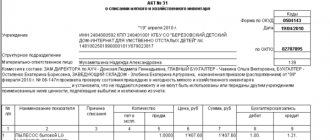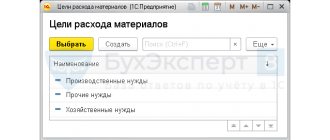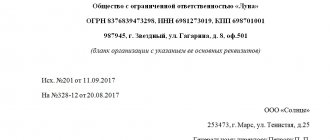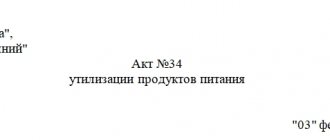The application of the act for writing off fuels and lubricants (fuels and lubricants) occurs at all enterprises and organizations that have transport equipment on their balance sheets, employ drivers and incur the costs of purchasing the necessary consumables for cars. The concept of “fuels and lubricants” includes:
- petrol,
- oil,
- brake fluid,
- various types of lubricants, etc.,
that is, in fact, all those liquids that no transport unit can do without.
- Form and sample
- Online viewing
- Free download
- Safely
FILES
Why do you need an act for writing off fuel and lubricants?
The act relates to primary documentation and is of great importance for the accounting and tax accounting of the organization. It allows you to calculate the expenses incurred by the company on fuels and lubricants in order to subsequently deduct them from profit, thus reducing the tax base.
It should be noted that in addition to the write-off act, to carry out this procedure, you must have one more document: the driver’s waybill, which reflects in detail information about the fuel and lubricants spent, kilometers traveled, time spent on the road and other data.
Waybills must be issued at the beginning of the working day, after which drivers are required to submit them to the accounting department (with an advance report that records the expenditure of cash issued for fuel, as well as checks and receipts).
What is a waybill
Write-off of fuel, like other types of inventory items, is carried out on the basis of a write-off act. Waybills, so-called vouchers, in themselves are not the basis for writing off fuel and lubricants, but the above-mentioned act is drawn up precisely according to the data contained in them.
The waybill has several unified forms that reflect the characteristics of the car, the tariffication of the driver’s work, the organizational and legal form of the company using it: for a passenger car, an individual passenger car, trucks, special vehicles, etc.
Question: How to record the write-off of fuel (fuel) purchased in cash? The cost of 125 liters of fuel and lubricants purchased by the driver of a company car in cash using funds received on account amounted to 5,000 rubles. The purchase of fuel and lubricants for this amount is confirmed by the employee’s advance report with an attached cash register receipt issued by a retail trade organization (gas station). The VAT amount is not highlighted in the receipt (the seller of fuel and lubricants applies the simplified tax system). Consumption of 100 liters of fuel and lubricants is confirmed by a waybill, also attached to the advance report. Tax accounting uses the accrual method. View answer
Application of these forms in accounting:
In the second case, it is permissible to develop your own voucher forms, taking into account the requirements of Federal Law-402 “On Accounting”, however, in practice, the same unified forms are often used for accounting and write-off of fuel and lubricants. It is worth noting that as of March 1, 2019, by order of the Ministry of Transport No. 467, changes were made to the procedure for filling out the PL, for example, the possibility of filling out one document for a month was canceled, as was before. Organizations that are not transport companies can draw up this document with such regularity that it allows them to confirm the costs of fuel and lubricants without being guided by orders of the Ministry of Transport. This conclusion can be drawn from letters from the Ministry of Transport and court decisions (post. FAS VVO A38-4082/2008-17-282-17-282 dated 04/27/09). Waybills are recorded in the logbook.
Commission approval
In order to legally write off fuels and lubricants, as well as to correctly draw up the act, the organization must create a special commission consisting of at least two people. For her appointment, the head of the enterprise issues a separate order. The commission should include employees from various departments, as well as a financially responsible person. In this case, it is advisable to allocate a chairman and ordinary members to the commission.
The commission’s tasks include reconciling actual fuel costs with the standards established by the company (it should be noted that they are different for each type of transport and must be approved separately), conducting test trips with drivers to check the amount of daily fuel, oil consumption, etc. , as well as collection of waybills for the reporting period.
NOTE! The creation of a commission is required only in large organizations; small businesses can do without it: here, to write off fuel and lubricants, a simple written decision of the head of the company is sufficient.
Accounting and tax accounting of fuels and lubricants
IMPORTANT! A sample fuel and lubricants write-off act from ConsultantPlus is available here
If you refer to the form of the waybill and the requirements contained in Order No. 152, the waybill reflects the following information necessary for accounting for fuel and lubricants:
- remaining fuel in the tank, delivery, balance at the time of closing the submarine;
- speedometer data at the beginning and end of the movement.
Fuel consumption can be calculated both directly from these data and from standards that determine how much fuel a particular vehicle uses per kilometer (Ministry of Transport standards, documents AM-23-R dated March 14, 2008, NA-51- r dated 6/04/18).
IMPORTANT! A sample fuel and lubricants write-off statement from ConsultantPlus is available here
The standards are advisory in nature, and if a company can justify other figures for fuel consumption or the vehicle it operates is not included in the regulatory documents, the legislation does not prohibit such things.
Expense justification can be based on:
- technical documentation of the vehicle;
- control measurements of fuel consumption in various weather and seasonal conditions, documented by commission acts.
It is permissible to approve one standard, and then apply coefficients to it, for example, of an increasing nature, in the winter. The use of fuel consumption standards requires regular inventories and reconciliation of actual consumption with calculated data. To account for costs, fuel is most often priced at the average cost.
The cost balance of fuels and lubricants is added to the cost of newly capitalized fuels and lubricants. The resulting value is divided by the sum of the remaining and received fuel and lubricants in kind. Fuel is accounted for in active account 10/3 and debited to “cost” accounts 20, 25, 44, etc.
Rules for drawing up an act for writing off fuel and lubricants
There is no standard unified, mandatory sample act for write-off of fuels and lubricants. Organizations and enterprises have every right to choose one of two main methods:
- each time, as needed, compose a document in any form (but this is not very convenient),
- Based on your needs, develop a document template yourself (in this case, it should be approved in the company’s accounting policies).
However, regardless of which option for drawing up the act form for writing off fuel and lubricants is chosen, you must adhere to certain rules in filling it out. In particular, it must indicate:
- Business name,
- date of document preparation,
- driver information,
- information about the make and license plate of the car,
- a complete list of write-off goods (indicating quantity and price).
In this case, information about write-off fuels and lubricants is best presented in the form of a table.
It is important to be very careful and even scrupulous when filling out the act; you must try to avoid mistakes and not enter false information into the document, which could lead to punishment from supervisory authorities.
Document form
The legislation does not require that the act be drawn up in accordance with a specific form. It is acceptable to compose it in a free style, but in reality many have developed special templates for this purpose. Such a template is developed by the organization and is reflected in its accounting policies.
Regardless of the template, the document always contains the following information:
- Title of the document;
- Date and place of registration;
- Information about the organization;
- Business operations that involved the consumption of materials;
- Units of materials consumed and their cost;
- Officials;
- Signatures of responsible employees.
Rules for drawing up the act
The act can be drawn up on the organization’s letterhead or on an ordinary A4 sheet - this does not matter, nor does it matter whether it is handwritten or printed on a computer.
There is one immutable condition: it must contain the original signatures of the persons responsible for the write-off.
It is also not necessary to put a seal on the act, since since 2016 legal entities have been exempted from the need to use seals and stamps in their activities.
After drawing up an act on the write-off of fuel and lubricants and its acceptance in the accounting and tax records of the company, the document is transferred for storage to the archive of the enterprise, where it must be kept for the period established by law.
How to avoid mistakes when drafting
To avoid errors that may be made during compilation, it is worth considering a number of rules:
- always use a prepared template: to do this, the company must put it into circulation through an internal decree
- always check actual data and established standards
- take into account external factors in the calculation that could or may affect the volumes
One way or another, an important rule that will always help to avoid mistakes is qualified personnel.
An example of drawing up an act for writing off fuel and lubricants
- At the beginning of the act, on the right or left (it doesn’t matter), a place is allocated for approval by the head of the company, the name of the enterprise and the date of drawing up the act are indicated.
- Next, in the middle, enter the name of the document and briefly indicate its meaning (in this case, it is “write-off of fuel and lubricants”).
- After this, the composition of the commission is entered into the act, indicating the positions of the employees, as well as their personal data.
- The next thing to note is the period for which fuels and lubricants are written off, as well as the make and state number of a particular vehicle.
- Below is the table. They fit into it
- fuels and lubricants subject to write-off,
their quantity (in liters),
- the norm of their consumption approved at the enterprise,
- actual consumption,
- price.
- Under the table, the direction of expenditure should be noted: in this case, these are “the needs of the organization,” as well as the documents attached to the act (the waybills are listed here in chronological order by number).
- At the end, the act should be certified by the signatures of all members of the commission with transcripts of autographs.
In those lines that remain blank, you need to put dashes.
Registration of a certificate of fuel consumption
Let's look at an example of compiling a certificate:
Now that all the nuances taking into account fuels and lubricants have been considered, it will not be difficult to devote time to optimizing costs. In addition, you should always remember about changing legislation, which establishes the procedure for generating reports, and adapt documents to it.
Top
Write your question in the form below
Cases that raise questions
There are few pitfalls when writing off fuels and lubricants for conventional vehicles. But what to do if some non-standard equipment was purchased, the consumption standards for which are not even on the lists of the Ministry of Transport? In this case, you should refer to the manufacturer’s documentation and technical specifications, which indicate the average “needs” of the device. Let's consider several similar cases:
Write-off of fuel and lubricants for engine running-in
This situation is characterized by increased consumption of materials both in the case of a new and a restored/repaired engine. And the biggest problem is not the calculation, but the proof of the legality of writing off such volumes of fuel and oil... The solution to this issue is quite simple: it is necessary to draw up a separate document on the cost norms for a particular engine, indicating its number and referring to the document confirming the purchase/repair of the device. Then, based on this document, a standard act is drawn up, in which an increased (up to 10%) amount of fuel and lubricants is written off.
Registration of a write-off report for cars without a speedometer
The main difficulty is in determining the path traveled. Since it is impossible to determine it from the initial and final speedometer readings, it is proposed to apply several additional measures:
- Count and indicate on the waybill the number of kilometers traveled;
- Take fuel level measurements before leaving and after returning the vehicle;
- Based on these indicators, develop a daily fuel consumption rate;
Then, in the above act, we fill out everything in the same way as for a regular car, only we indicate days instead of mileage.
Sample write-off for a lawn mower
As in the previous case, it is worth drawing up a separate document “Calculation of device performance of a Lawn Mower brand...”, which will indicate the main characteristics (engine size, fuel tank, device model, duration of operation at one gas station, etc.). It is also worth drawing up a document confirming the fact of work (mowing the lawn) indicating the position and full name of the performer, time of work, volumes completed, etc. Then, with reference to these documents, a sample and final version of the act is drawn up. Moreover, the same form is used, only instead of mileage it is necessary to indicate the number of engine hours worked.
Fuel consumption per generator
Improvised heating and heating systems, other rarely used devices are also calculated from test indicators and technical documentation, and then reflected in the act as the result of measurements/research by a special commission. In addition, it is recommended to send a sample calculation and report to a legal or accounting firm to check and confirm that the above devices will not work “for free” due to the cancellation of expense reports.
You will find even more useful information on the topic in the video below.
Post Views: 1,764
Fuel write-off for a diesel power plant
The rated power of generators is indicated in kilowatts (kW).
In addition to the operating hours of the station, the diesel operator can record which welding machine is connected to it. A fact of economic life in this case is still the amount of fuel consumed (clause 8 of Article 3 of Law No. 402-FZ). However, when converting engine hours into liters based on the factory consumption rate, the same problems arise as when writing off fuel and lubricants based on the mileage of the car.
The application of the act for writing off fuels and lubricants (fuels and lubricants) occurs at all enterprises and organizations that have transport equipment on their balance sheets, employ drivers and incur the costs of purchasing the necessary consumables for cars. The concept of “fuels and lubricants” includes:
- petrol,
- oil,
- brake fluid,
- various types of lubricants, etc.,
that is, in fact, all those liquids that no transport unit can do without.
How it works
Fuel cards are a convenient means of payment that helps companies organize control and reduce labor and monetary costs for fuel and lubricants. To ensure that funds are not spent uncontrollably, accounting is needed. To do this, they keep a log of the movement of fuel cards - a sample can be compiled in any form, there are no requirements for document execution.
A company that wants to use electronic media to pay for fuel and lubricants enters into an agreement with a fuel supplier. Most gas station chains offer such agreements.
The essence of the service is that the organization transfers funds to smart cards, which can only be used to purchase fuel from the gas station network. Before this, an agreement is drawn up with the gas station to refuel the company’s cars with petroleum products using smart cards.
An annex to the agreement may be a fuel card registration log; You can usually download the form on the website of the gas station network.
At the end of the month, the fuel supplier issues the company an act (invoice) confirming the quantity and cost of gasoline purchased, as well as a report indicating the dates of refueling and the volume of fuel filled.
Calculation example
Let us use a conditional example to explain the procedure for writing off fuel according to waybills. Almaz LLC has a certain brand of gasoline in stock, 70 liters, at a price of 42 rubles. This month, 100 liters of fuel of the same brand were purchased at a price of 40 rubles, and 40 liters were dispensed. Fuel and lubricants are written off at average cost.
The average write-off value will be:
- 70 * 42 = 2940 rubles;
- 100 * 40 = 4000 rub.;
- 2940 + 4000 = 6940 rubles;
- 70 + 100 = 170 l;
- 6940 / 170 = 40.82 rubles.
Based on actual fuel consumption, costs are calculated as follows:
- The waybill shows the remaining fuel in the tank is 5 liters, 40 liters were filled, the remainder after the flight is 10 liters.
- Actual consumption: 5 + 40 – 10 = 35 l.
- Having assessed this expense according to the calculated cost, we obtain the cost of fuel and lubricants: 35 * 40.82 = 1428.70 rubles.
- Let the car be used for official purposes by the deputy director, then the costs will be written off Dt 26 Kt 10/3 for maintenance.
When calculating according to standards, the calculation formula is taken from document AM-23-R. The car, the waybills of which we took for the calculation, is a passenger car, the formula (p. 2, p. 7) will be as follows: Qн = 0.01 * Hs * S * (1 + 0.01 x D), where:
- D – correction factor in percentage established in the organization;
- S—mileage;
- Hs – consumption rate per 100 km.
Seasonal coefficient D (winter, increasing, reflecting increased gasoline consumption) is not applied. The consumption rate for this model is 8.8 l. The recorded speedometer readings when leaving were 2510, when returning - 2565.
- Mileage: 2565 - 2510 = 55 km.
- Flow: Qn = 0.01 * 8.8 * 55 * (1 + 0.01) = 0.01 * 8.8 * 55 * 1.01 = 0.01 * 484 * 1.01 = 4.84 * 1.01 = 4.89 l.
- 4.89 * 40.82 = 199.61 rub.
- Wiring: Dt 26 Kt 10/3 199.61 rub.







